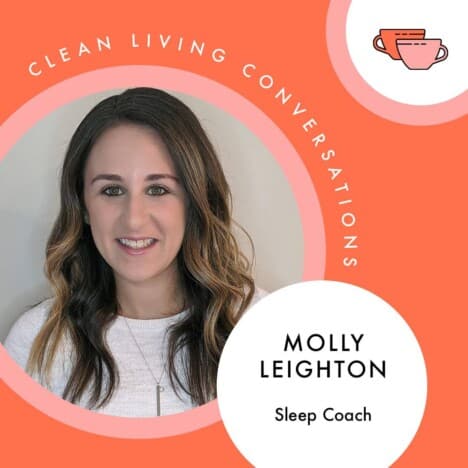This post may contain affiliate links. Please read my disclosure policy.
As I’ve shared my experiences with pregnancy and postpartum over the last year, I’ve gotten a lot of questions about how I’ve taken care of my body through these big transitions. Many of you have wondered specifically about my workout routine! For this reason — and because she’s generally awesome — I’m thrilled to welcome my personal trainer Meaghan Shea as my guest for our latest Clean Living Conversation.

How to Work Movement Safely Into Your Life: A Q+A With My Personal Trainer Meaghan Shea
I started working with Meg about three years ago. We connected in the midst of my journey to address some personal health issues (read more here) as a way to improve my balance and to approach fitness from a more medical perspective. It was the perfect fit, because Meg’s expertise is in a field that’s actually called medical exercise. (She’ll tell you more about that below!)
In the years that Meg and I have worked together, my goals have changed so much, and she’s met me at every step of the way. She was there to support me as I was looking to improve my own health, helped me find safe ways to move while I was pregnant with Skylar, and coached me through the tricky postpartum phase. More recently, we’ve started focusing on building balance and strength — all through virtual Zoom training sessions! I am so grateful to have her in my life.
Meg has quite the resume and so much knowledge to share. In addition to being a personal trainer herself, she actually trains aspiring personal trainers, so she really knows her stuff. Meg says she likes to think she has the experience and expertise to work with anyone, and most of her personal training clients have medical conditions or musculoskeletal issues. She also coaches CrossFit.
Time to hand it over to Meg!
What inspired your interest in wellness and fitness? What led you to pursue your specific path and to do the work you do in the fitness industry now?
I was a collegiate athlete and became interested in personal fitness through our team training program. But I think what made me pursue helping others achieve better health was that my father was diagnosed with diabetes and heart disease around the same time. I started personal training pretty much right after college, but it wasn’t until about five years later that I went back to school and got my Masters degree in Exercise Physiology from Columbia University. The company I was working for in NYC was looking to start a vocational school for personal trainers and I wanted to (and did) teach and eventually direct there.
Can you tell us more about your formal training and what the process of becoming a personal trainer looked like?
Like many people who entered the field when I did, I spent the first year or so not really knowing what I was doing. I barely passed my first certification, and most of my learning was self-study alongside my peers. I didn’t have a degree or experience in the field because personal training was not [initially] my intended career choice. I got multiple advanced certifications, and when I really decided to advance what was, in fact, now my career, I went back to school to get a degree and began teaching others how to streamline the process.
Do all trainers have the same training? Do you have any tips for someone looking for a trainer who really knows their stuff?
All trainers definitely do NOT have the same training! Personal training is an unregulated field with really no requirements. That said, degrees and advanced certifications — along with experience — show dedication to the practice.
When you’re looking for a trainer, definitely look for advanced degrees and certifications that suggest someone is career-oriented and not just a fitness enthusiast with little knowledge of exercise science. At the end of the day, any certification is simply a piece of paper. It’s the application of acquired knowledge that counts. Experience and proven results from working with other people who share your goals and/or specific conditions are key. If you’re interviewing trainers rather than receiving a direct referral from someone you trust, ask for client testimonials. I think it’s also very important to find a trainer who you actually enjoy spending time with so that you look forward to your workouts, rather than dreading them. Previous clients can give you insight on that, as well.
What is your favorite thing about working with clients as a personal trainer? What is the biggest challenge?
My favorite thing is definitely watching people achieve more than they thought they could. In a way, this is also the biggest challenge. Most people get in their own way and let their mental barriers prevent them from being their best. Motivation and the psychology game are tough because they’re unique to the individual.
Tell us more about medical exercise! How does this differ from other approaches to fitness?
The Medical Exercise Specialist program is a self-study certification for personal trainers, but is put together by physical therapists. It explains over 50 different medical conditions and how they are dealt with in the clinic and progressively improved by physical therapy. But the most important part is that the underlying anatomy — the do’s and don’ts of each condition — is explicated so that personal trainers understand which movements will help [or] hurt the condition and can thereby select appropriate movements, regardless of equipment and setting.
What advice would you give to someone who is new to working out and is at the very beginning of getting into a new workout/movement routine?
Don’t burn yourself out! Nothing kills motivation like being injured or even just excessively sore because you go too hard and fast too soon. It’s also extremely helpful to learn how to move properly, simply because learning on a clean slate is much easier than having to undo bad habits later on after they’ve become ingrained in your nervous system.

It can be overwhelming to think about putting together a home “gym.” Do you have any tips for doing this, especially if you’re on a budget or have limited space?
You can do a lot with just a set of adjustable dumbbells and your own body weight. If I had to add anything else, maybe a moderately heavy kettlebell and a set of resistance bands. Both are quite versatile, but also effective for both strength and metabolic training.
Do you have any suggestions for people who want to find more time to move during their busy days?
I tell a lot of my clients to drink water consistently throughout their work day so that they have to get up to use the bathroom frequently. While some find this disruptive, it gives people an opportunity to stand up, move, and maybe get in an anti-desk posture stretch or two that I give them.
How can people prevent injuries while working out?
This goes back to learning how to move properly first and not doing too much too soon! Additionally, if [a movement] sounds simple but hurts beyond normal muscle discomfort, don’t do it.
What are a few rules of thumb you would offer to women who want to exercise while pregnant? Once cleared to exercise, what should people know before they ease back into fitness postpartum?
First, you CAN exercise while pregnant… even if you’ve never exercised before! There are just a few guidelines that need to be followed. Not much has to change at all until after the first trimester, when the baby starts to really grow. Posture changes so that the glutes and core stability versus movement (think planks versus crunches) should be prioritized to limit excessive pressure and tearing in the abdominal wall. Additionally, because the body is already working harder to support the growing baby, exercise intensity should be reduced to around a 5-6 on a scale of 1-10. Prolonged standing still during sessions isn’t great because of potential blood pooling, and long warm-ups and cool downs are important for this same reason. Prolonged time on your back should also be avoided due to abdominal pressure and potential for restricted blood flow to the heart. Pelvic floor strengthening with moves like kegels will aid in delivery and postpartum bladder control, but because of hormonal changes, you should avoid any unnecessary stretching.
After you’re cleared postpartum (usually about six weeks post-delivery, pending no complications), posture and pelvic floor moves will need continual attention, as things don’t just go back to normal overnight.
Do you have any advice for what to eat before and after a workout?
This is highly individual. I’ve trained myself to work out in the morning before eating anything and to consume a high-protein, moderate carb, and moderate fat meal about an hour later, once I feel hungry. Some people find that some easily digestible carbohydrates and protein prior to exercise is helpful for their energy [levels]. But really, the body is highly adaptable and tends to adjust to what and when you feed it. Nutrient timing isn’t nearly as important as people think.
The one thing you probably should avoid before working out is high-fiber foods and anything heavy that’s likely to sit in your stomach.
Let’s turn to our Clean Living Conversations signature questions! You’ll find these questions in every installment of this Q+A series!
What is one thing that is guaranteed to make you laugh? I’m totally dating myself here, but I still laugh at just about every line of Dumb and Dumber.
What do you eat for breakfast? I don’t.
What’s one assumption about the fitness industry that you’re tired of hearing? No pain, no gain! Exercise is uncomfortable, but it should never hurt.
Finish this sentence: I never leave the house without… a mask! (Can we leave the house now? I can’t keep it straight.) Jokes aside, before COVID, [it was] definitely a full water bottle.
What is the best book you’ve ready this year? The best podcast you’ve listened to? I tend to read more articles than books, but I do love me a good podcast. Joe Rogan has some great guests and topics, and he recently interviewed Alex Berenson on all things COVID. While there are some controversial topics covered, I thought it was great that someone finally came out and talked about the importance of controllable things like sleep, exercise, and nutrition for healthy immune support during these crazy times.
After all of the questions I’ve received about my personal fitness regimen, I’m so glad I had the opportunity to introduce you all to Meg! If you want to learn more about the work she does, a virtual consult, and about her philosophies on health and fitness, send her a DM on Instagram @mksheba25!






